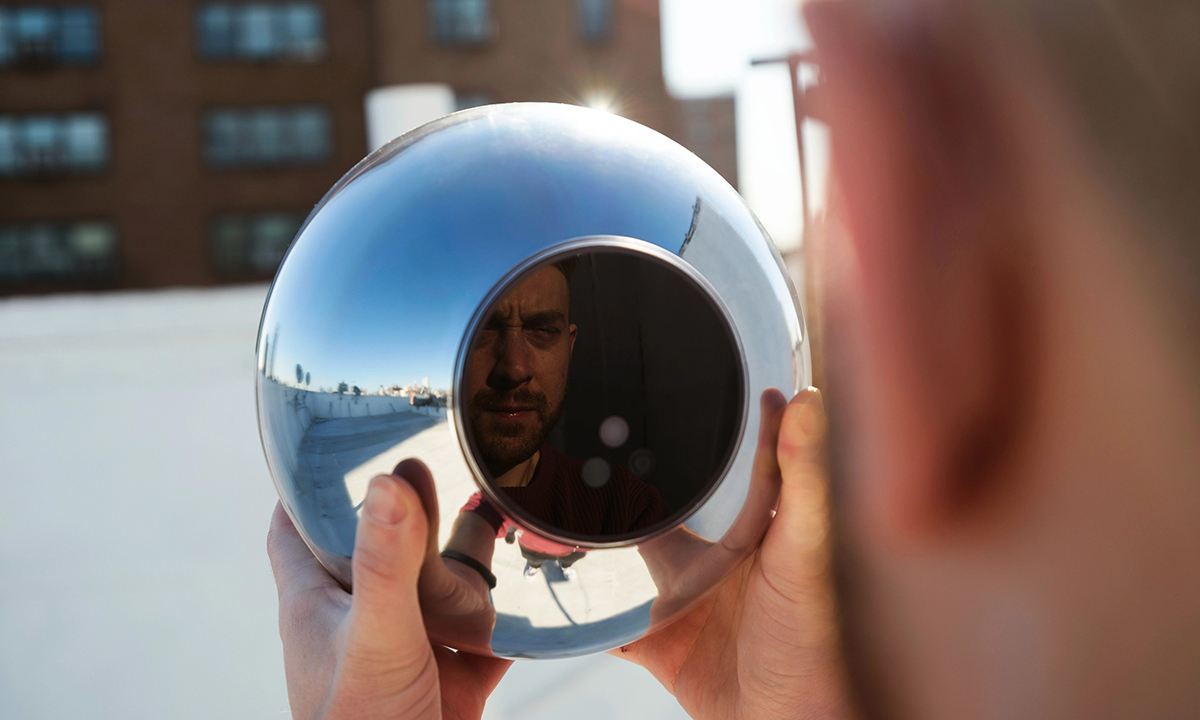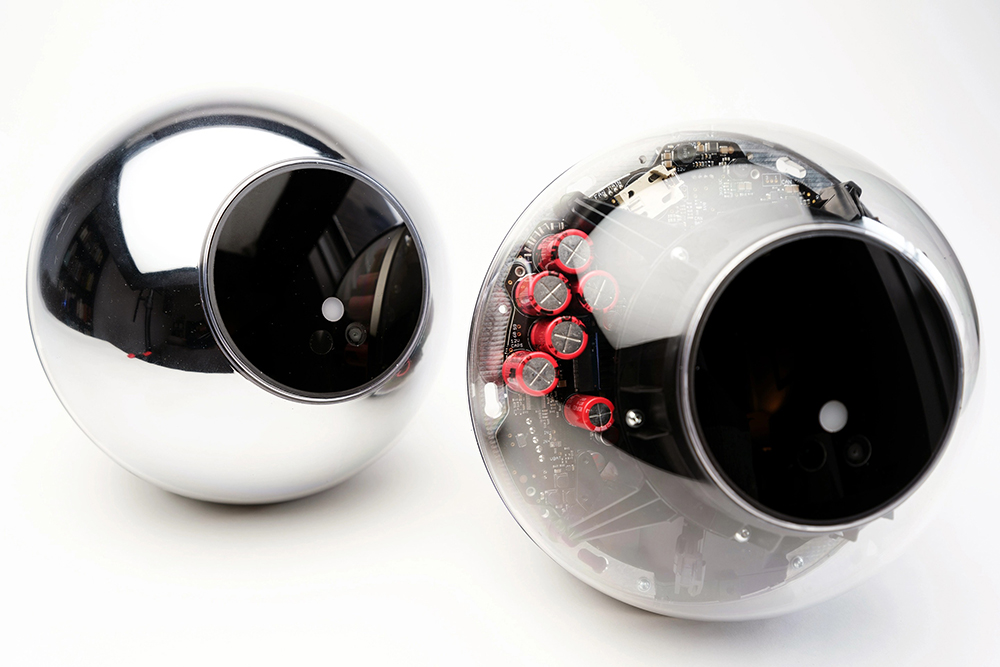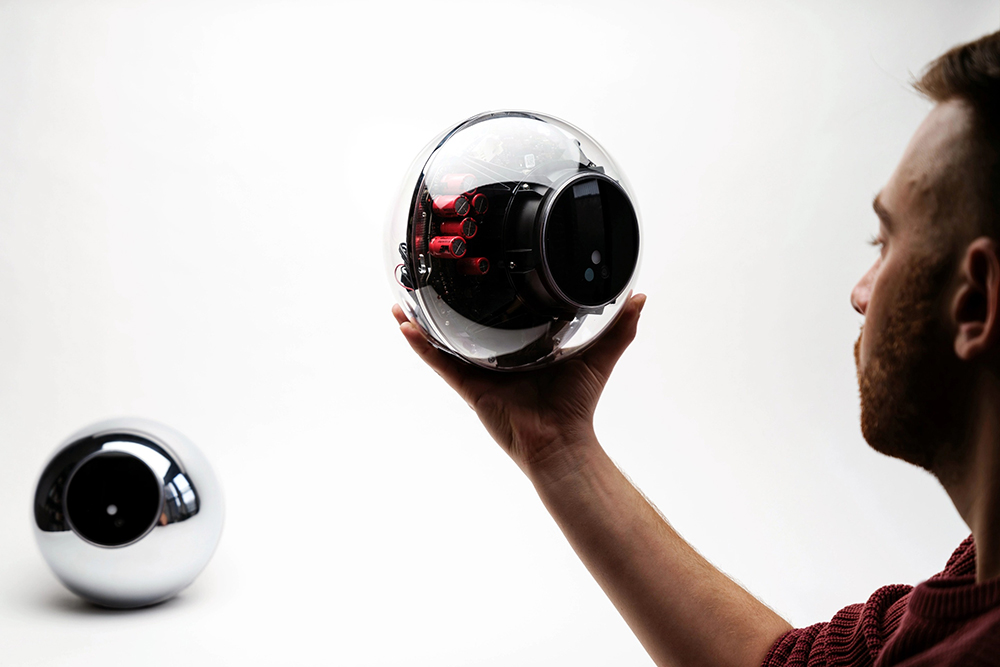
Worldcoin扫描球很像是史蒂夫·乔布斯设计的保龄球,也类似于超大号的HAL 9000(电影《2001太空漫游》中的超级计算机)所拥有的魔力8号球。整个球体的外表十分光滑,但止于前端的黑色圆形豁口,里面装着三个感应器,呈三角形排列。
制作球形的物体对于工程学来说是一个噩梦,但其背后的重大象征意义却不容忽视。该球体并非是正圆,而是由两个半球拼凑而成,其拼接角度与地球的轨道相吻合。它的设计者是苹果公司(Apple)的传奇人物乔尼·艾夫招聘的第一个员工——托马斯·迈耶霍夫尔。
扫描球虽然属于惊艳之作,但它的功能却十分简单:扫描人的虹膜,并将生物特征图片转换为无法破解的一串数字,Worldcoin将其称之为“虹膜密码”(IrisCode)。通过结合相应的算法,这个密码将证明你作为人类的独特性。
每周约有4万名民众接受扫描。在今年3月一个寒冷的周日,我成为了其中一员,一名携带扫描球的Worldcoin员工来到了我在布鲁克林的公寓。
我在这两年间也读到过关于这家公司的一些报道,因此也就欣然接受了与扫描球面对面接触的机会。最终,当技术人员将它从一个特别设计的背包中取出来并与互联网热点相连之后,我看见了其内部的模样。球体发出了哔哔啵啵的声音,在扫描我的虹膜时亮起了白光和红光,然后将加密结果传回了数据中枢。在经历了约45秒之后,我手机上的World应用程序亮了,显示验证已经成功。毕竟,我还是我自己。

这段时间以来,硅谷在新奇创意方面的表现不尽人意。期间“Uber-for-X”曾经再次现身。受此影响,风投资本的从众心理将每一款应用程序转换为其他公司的复制品。然而,即便这样也是无力回天,因为专注于基础设施或薪资软件、以业务为中心的产品如雨后春笋般涌现。
作为对比,Worldcoin的错误倒是具有原创性,而且始于这个扫描球——它可能是自iPad以来最具标志性的硬件。它是这么标榜自己的:地球上有80亿人。我们如何证明每个人都是真正的人类?Worldcoin的解决方案是通过隐私保护协定,对每个年满18岁的人进行分类,并给每个人发放加密货币奖励,而该加密货币反过来将成为新的全球货币标准。
“雄心壮志”一词已经不足以描述这个理念以及联合创始人、OpenAI的创建者萨姆·奥尔特曼。
在Worldcoin的计划细节首次遭到泄露后的两年时间中,批评声接踵而至,从隐私顾虑、潜在的劳工虐待一直到理念过于怪异的看法。一落千丈的加密货币市场也给Worldcoin的全球征服策略蒙上了阴影。
OpenAI及其ChapGPT工具的惊艳亮相可能有助于扭转Worldcoin的运势。ChatGPT创纪录的用户增速,引发了风投资金的疯狂涌入。
与Worldcoin高管、投资者和用户的对话显示,这两家公司对不远的将来有着共同的憧憬——它将是一个人工智能无处不在的未来,而且我们需要一支势均力敌的力量,从而让人类控制自己的命运。随着Worldcoin奔向未来世界之际,该项目必须说服数十亿民众:公司正在致力于预防反乌托邦噩梦的出现,而不是在催生这一噩梦。
证明“人类特征”
Worldcoin的母公司Tools for Humanity的首席执行官亚历克斯·布拉尼亚在2020年加入奥尔特曼最新创建的这家公司时正在攻读理论物理学的博士学位。他受到了人工智能系统理念的感召,该理念呼吁向全球人口均等地发放金钱,并将其作为一种普遍的基本收入。
创始团队早些时候还使用虹膜扫描来验证布拉尼亚所称的“人类特征”。布拉尼亚指出,指纹可以被篡改,而且面部的重新认证十分容易,但与更大的数据组进行对比几乎是不可能的事情。司机的驾照或个人秘钥可能会被偷盗或丢失,也有可能被复制或篡改。
布拉尼亚说:“我们知道这一点听起来十分奇怪,而且我们自己在开始这个项目时也觉得十分奇怪。然而,此举基本上是该问题的唯一解决方式。”
另一个困难就是说服其他人接受这一理念。奖励是一种办法:当人们接受扫描、验证并上载至Worldcoin之后,他们会收到25枚被称之为Worldcoin的专属加密货币。这些代币在未来可能会成为一笔财富,但在该项目大规模铺开之前,这些代币没有什么价值可言。
居住在葡萄牙的一位30岁网络企业家成为了较早接受扫描的人士,他通过聊天软件Discord告诉我,他希望自己获得的这些代币在未来能够价值连城。不过,他对于Worldcoin产品发布的不断推迟感到失望。
在Worldcoin的试用过程中,公司还尝试过发放其他奖励,从加密货币,例如令人兴奋的比特币(Bitcoin)和泰达币(Tether),一直到苹果耳机AirPods,但依然不够。
布拉尼亚回忆了自己当时拿着最初版本的虹膜扫描硬件在柏林东奔西走的情形,当时这个设备看起来像一个普通的蓝色保龄球。没有人愿意接受扫描。该团队不断更新其设计,一方面则是为了试试人们对其光滑银色外表的反应。突然间,人们开始走到他面前。这个扫描球成了开启对话的引子。
Worldcoin异常大胆的想法引发了顶级投资者的兴趣,公司在2022年年初的估值达到了30亿美元。在彭博社(Bloomberg)于2021年6月首次报道Worldcoin之后,扫描球很快吸引了大量的注意力和愤怒之声。Worldcoin的高管和投资者对《财富》杂志表示,其中一部分是冲着其设计来的。
Variant Fund的联合创始人及普通合伙人杰西·沃尔登说:“要想让Worldcoin失败,那就得确保没有人可以知晓这款产品。”

即便如此,公司的抱负——打造“去中心化”的未来,这家总部位于硅谷的公司会对人类进行扫描和记录——散发出与殖民主义相似的味道。不过,Worldcoin的母公司Tools for Humanity坚持认为这一流程在未来某一天将完全开源,并由非营利性机构Worldcoin Foundation运营。不出意外,这家公司遭到了大量的奚落和曝光,其中包括爱德华·斯诺登。他发表推文称:“人类的身体并非是剪票钳。”
在2022年4月紧挨着的两天中,BuzzFeed News和《麻省理工科技评论》(MIT Tech Review)分别发布了调查。在这两项调查里,记者控诉Worldcoin在发展中国家的试用充满了欺骗性的承诺,承诺对象既有扫描球运营商,也有参与者。其他控诉包括违反隐私法,甚至是腐败。
布拉尼亚称这些报道有失公允,并表示出现这些问题的原因在于公司依然在进行验收测试,并在这一过程中会自然而然地出现意外。他说:“很明显,进展过程并不完美,而且很多事情需要改善。公司依然处于早期阶段。”
布拉尼亚与 Tools for Humanity产品负责人蒂亚戈·萨达称,该流程自那之后便一直处于优化当中,以确保隐私能够得到充分保护。他们解释说,在机器捕捉到虹膜之后,生物特征数据永远都不会离开球体,而是会被转化为虹膜密码,该密码仅用于通过复杂的零知识证明和原型Danksharding系统来创建有关个人独特性的验证。安德森-霍洛维茨公司(Andreessen Horowitz)的首席技术官埃迪·拉扎林坚持认为,虹膜密码无法被逆转,并被用于重构虹膜图像,或至少现在是这样。
如果这一切听起来一头雾水,那么重点在于,按照Worldcoin的话来讲,公司已经设计了一个完美的系统来证明人类的独特性,而且不会影响个人隐私保护。
全球性的加密货币
更大的问题在于,Worldcoin是否可以实现其几乎异想天开的规模。继2022年一连串不良新闻事件之后,Worldcoin悄然消失在人们的视野中,并进一步受到了加密货币寒冬的冲击。它继续招募新的参与者,但其节奏远不及自己以前提出的目标,也就是在2022年年底之前获得2,000万至3,000万注册用户,并生产6,000枚扫描球。如今,Worldcoin已经签下了近140万用户,任何时间都有100枚至200枚扫描球在工作。以每周4万个验证的数量来看,公司需要近2,000年的时间才能够完成全球当前近半数人口的注册。不过,布拉尼亚称,公司还远未到满负荷运转的地步。
OpenAI与ChatGPT的爆发式增长重燃了公司对该项目的希望。这两家公司始终都在齐头并进,这也是萨姆·奥尔特曼愿景的一部分,即在这个由人工智能定义的世界中,应该创建一种公平有效的方式来分发人人可以享有的无条件基本收入(UBI)。他的这一愿景也得到了布拉尼亚及其投资者的认可。
布拉尼亚指出,希望在于,Worldcoin实际上能够“让尽可能多的人口获得这项技术带来的益处。”简而言之,如果人工智能接手了我们的所有工作,Worldcoin就可以成为一种分发机制,以确保后续的资本创造不会把控在少数人的手中。
该项目的无条件基本收入抱负看起来依然不是很成熟。当我问及其机制时,Variant的沃尔登和a16z的拉扎林都拒绝回答,而且布拉尼亚模糊地提到了打造所谓的“意外条款”(Windfall Clause),一旦营收达到全球GDP的2.5%,这几家公司就必须分享其营收。
“货币”元素本身也是十分微妙。尽管Tools for Humanity团队希望Worldcoin在今后的规模能够超越比特币,甚至是美元,但Worldcoin代币只有在所有人同意接受时才会有价值,这是个先有鸡还是先有蛋的问题,说得好听点是社会共识,说得难听点就是庞氏骗局。
令局势更为复杂的是,美国和其他首要国家的监管方是否会批准Worldcoin的加密货币。Worldcoin雇员提出要来我的公寓,目的是防止给人留下公司在纽约设有分支机构的印象。公司最终计划在美国提供验证服务,但不发行代币。
除了其加密货币组件之外,Worldcoin不同的功能简直完美契合人工智能的快速增长趋势,即证明人类是人类。拉扎林表示:“每个人都有深度伪造的时候,而且也都会听到语音合成。很明显,要区分哪些是机器生成的内容以及哪些是人类制作的内容将变得越发困难。”
为了利用不断增长的使用案例,并提供更为直接的货币化路线,Worldcoin在上周推出了一个功能,名为“世界身份”(World ID),这是人们在通过Worldcoin验证后得到的一个徽章,可以在互联网中佩戴,以证明你并非是人工智能机器。
在公司的愿景中,世界身份将加入或替代用户名和密码。登录平台的用户将使用其World应用。在这个充斥着人工智能的世界里,该应用程序在证明某人身份时有望成为一种匿名效果较好的高大上解决方案。
隐私领域专家、牛津大学人工智能伦理研究所(Oxford’s Institute for Ethics in A.I.)的高级研究员伊丽莎白·雷尼尔斯称,Worldcoin正在对自身进行定位,以便从萨姆·奥尔特曼这家知名公司创造的人工智能主导的社会中谋取收益。雷尼尔斯告诉我:“奥尔特曼的一家公司负责制造问题,另一家则负责出售针对该问题的解决方案。这种关系有点类似于医药公司先向市场推出危险的高度致瘾药物,然后尝试出售治疗这种成瘾症的新药。”
布拉尼亚对此表示否认,称人工智能的挑战并不仅仅源于OpenAI。奥尔特曼并未提供任何采访机会。
如今,Worldcoin依然处于验收测试阶段。尽管心怀去中心化的抱负,但公司并未完全公开其协定。不过,扫描球的大部分电路图已经在GitHub上公布。布拉尼亚希望,其他人在未来某一天将创建自有的验证设备,而Tools for Humanity将退至幕后。
然而,这家母公司还未公布该项目的代币经济学,也就是Worldcoin代币铸造与分发的具体细节。据知情人士透露,70%以上的代币将流向Worldcoin注册者,剩余的将流向Tools for Humanity及其投资者。公司可能会在2023年上半年发行代币。
OpenAI征服互联网的举动依然在继续,于3月中旬推出了其最新的大型语言模型的最新版本——GPT-4。与此同时,Worldcoin正在等待时机,而且制造了数千个新扫描球设备用于在全球范围内使用,并豪赌数十亿民众将十分乐意一窥未来。(财富中文网)
译者:冯丰
审校:夏林
Worldcoin扫描球很像是史蒂夫·乔布斯设计的保龄球,也类似于超大号的HAL 9000(电影《2001太空漫游》中的超级计算机)所拥有的魔力8号球。整个球体的外表十分光滑,但止于前端的黑色圆形豁口,里面装着三个感应器,呈三角形排列。
制作球形的物体对于工程学来说是一个噩梦,但其背后的重大象征意义却不容忽视。该球体并非是正圆,而是由两个半球拼凑而成,其拼接角度与地球的轨道相吻合。它的设计者是苹果公司(Apple)的传奇人物乔尼·艾夫招聘的第一个员工——托马斯·迈耶霍夫尔。
扫描球虽然属于惊艳之作,但它的功能却十分简单:扫描人的虹膜,并将生物特征图片转换为无法破解的一串数字,Worldcoin将其称之为“虹膜密码”(IrisCode)。通过结合相应的算法,这个密码将证明你作为人类的独特性。
每周约有4万名民众接受扫描。在今年3月一个寒冷的周日,我成为了其中一员,一名携带扫描球的Worldcoin员工来到了我在布鲁克林的公寓。
我在这两年间也读到过关于这家公司的一些报道,因此也就欣然接受了与扫描球面对面接触的机会。最终,当技术人员将它从一个特别设计的背包中取出来并与互联网热点相连之后,我看见了其内部的模样。球体发出了哔哔啵啵的声音,在扫描我的虹膜时亮起了白光和红光,然后将加密结果传回了数据中枢。在经历了约45秒之后,我手机上的World应用程序亮了,显示验证已经成功。毕竟,我还是我自己。
这段时间以来,硅谷在新奇创意方面的表现不尽人意。期间“Uber-for-X”曾经再次现身。受此影响,风投资本的从众心理将每一款应用程序转换为其他公司的复制品。然而,即便这样也是无力回天,因为专注于基础设施或薪资软件、以业务为中心的产品如雨后春笋般涌现。
作为对比,Worldcoin的错误倒是具有原创性,而且始于这个扫描球——它可能是自iPad以来最具标志性的硬件。它是这么标榜自己的:地球上有80亿人。我们如何证明每个人都是真正的人类?Worldcoin的解决方案是通过隐私保护协定,对每个年满18岁的人进行分类,并给每个人发放加密货币奖励,而该加密货币反过来将成为新的全球货币标准。
“雄心壮志”一词已经不足以描述这个理念以及联合创始人、OpenAI的创建者萨姆·奥尔特曼。
在Worldcoin的计划细节首次遭到泄露后的两年时间中,批评声接踵而至,从隐私顾虑、潜在的劳工虐待一直到理念过于怪异的看法。一落千丈的加密货币市场也给Worldcoin的全球征服策略蒙上了阴影。
OpenAI及其ChapGPT工具的惊艳亮相可能有助于扭转Worldcoin的运势。ChatGPT创纪录的用户增速,引发了风投资金的疯狂涌入。
与Worldcoin高管、投资者和用户的对话显示,这两家公司对不远的将来有着共同的憧憬——它将是一个人工智能无处不在的未来,而且我们需要一支势均力敌的力量,从而让人类控制自己的命运。随着Worldcoin奔向未来世界之际,该项目必须说服数十亿民众:公司正在致力于预防反乌托邦噩梦的出现,而不是在催生这一噩梦。
证明“人类特征”
Worldcoin的母公司Tools for Humanity的首席执行官亚历克斯·布拉尼亚在2020年加入奥尔特曼最新创建的这家公司时正在攻读理论物理学的博士学位。他受到了人工智能系统理念的感召,该理念呼吁向全球人口均等地发放金钱,并将其作为一种普遍的基本收入。
创始团队早些时候还使用虹膜扫描来验证布拉尼亚所称的“人类特征”。布拉尼亚指出,指纹可以被篡改,而且面部的重新认证十分容易,但与更大的数据组进行对比几乎是不可能的事情。司机的驾照或个人秘钥可能会被偷盗或丢失,也有可能被复制或篡改。
布拉尼亚说:“我们知道这一点听起来十分奇怪,而且我们自己在开始这个项目时也觉得十分奇怪。然而,此举基本上是该问题的唯一解决方式。”
另一个困难就是说服其他人接受这一理念。奖励是一种办法:当人们接受扫描、验证并上载至Worldcoin之后,他们会收到25枚被称之为Worldcoin的专属加密货币。这些代币在未来可能会成为一笔财富,但在该项目大规模铺开之前,这些代币没有什么价值可言。
居住在葡萄牙的一位30岁网络企业家成为了较早接受扫描的人士,他通过聊天软件Discord告诉我,他希望自己获得的这些代币在未来能够价值连城。不过,他对于Worldcoin产品发布的不断推迟感到失望。
在Worldcoin的试用过程中,公司还尝试过发放其他奖励,从加密货币,例如令人兴奋的比特币(Bitcoin)和泰达币(Tether),一直到苹果耳机AirPods,但依然不够。
布拉尼亚回忆了自己当时拿着最初版本的虹膜扫描硬件在柏林东奔西走的情形,当时这个设备看起来像一个普通的蓝色保龄球。没有人愿意接受扫描。该团队不断更新其设计,一方面则是为了试试人们对其光滑银色外表的反应。突然间,人们开始走到他面前。这个扫描球成了开启对话的引子。
Worldcoin异常大胆的想法引发了顶级投资者的兴趣,公司在2022年年初的估值达到了30亿美元。在彭博社(Bloomberg)于2021年6月首次报道Worldcoin之后,扫描球很快吸引了大量的注意力和愤怒之声。Worldcoin的高管和投资者对《财富》杂志表示,其中一部分是冲着其设计来的。
Variant Fund的联合创始人及普通合伙人杰西·沃尔登说:“要想让Worldcoin失败,那就得确保没有人可以知晓这款产品。”
即便如此,公司的抱负——打造“去中心化”的未来,这家总部位于硅谷的公司会对人类进行扫描和记录——散发出与殖民主义相似的味道。不过,Worldcoin的母公司Tools for Humanity坚持认为这一流程在未来某一天将完全开源,并由非营利性机构Worldcoin Foundation运营。不出意外,这家公司遭到了大量的奚落和曝光,其中包括爱德华·斯诺登。他发表推文称:“人类的身体并非是剪票钳。”
在2022年4月紧挨着的两天中,BuzzFeed News和《麻省理工科技评论》(MIT Tech Review)分别发布了调查。在这两项调查里,记者控诉Worldcoin在发展中国家的试用充满了欺骗性的承诺,承诺对象既有扫描球运营商,也有参与者。其他控诉包括违反隐私法,甚至是腐败。
布拉尼亚称这些报道有失公允,并表示出现这些问题的原因在于公司依然在进行验收测试,并在这一过程中会自然而然地出现意外。他说:“很明显,进展过程并不完美,而且很多事情需要改善。公司依然处于早期阶段。”
布拉尼亚与 Tools for Humanity产品负责人蒂亚戈·萨达称,该流程自那之后便一直处于优化当中,以确保隐私能够得到充分保护。他们解释说,在机器捕捉到虹膜之后,生物特征数据永远都不会离开球体,而是会被转化为虹膜密码,该密码仅用于通过复杂的零知识证明和原型Danksharding系统来创建有关个人独特性的验证。安德森-霍洛维茨公司(Andreessen Horowitz)的首席技术官埃迪·拉扎林坚持认为,虹膜密码无法被逆转,并被用于重构虹膜图像,或至少现在是这样。
如果这一切听起来一头雾水,那么重点在于,按照Worldcoin的话来讲,公司已经设计了一个完美的系统来证明人类的独特性,而且不会影响个人隐私保护。
全球性的加密货币
更大的问题在于,Worldcoin是否可以实现其几乎异想天开的规模。继2022年一连串不良新闻事件之后,Worldcoin悄然消失在人们的视野中,并进一步受到了加密货币寒冬的冲击。它继续招募新的参与者,但其节奏远不及自己以前提出的目标,也就是在2022年年底之前获得2,000万至3,000万注册用户,并生产6,000枚扫描球。如今,Worldcoin已经签下了近140万用户,任何时间都有100枚至200枚扫描球在工作。以每周4万个验证的数量来看,公司需要近2,000年的时间才能够完成全球当前近半数人口的注册。不过,布拉尼亚称,公司还远未到满负荷运转的地步。
OpenAI与ChatGPT的爆发式增长重燃了公司对该项目的希望。这两家公司始终都在齐头并进,这也是萨姆·奥尔特曼愿景的一部分,即在这个由人工智能定义的世界中,应该创建一种公平有效的方式来分发人人可以享有的无条件基本收入(UBI)。他的这一愿景也得到了布拉尼亚及其投资者的认可。
布拉尼亚指出,希望在于,Worldcoin实际上能够“让尽可能多的人口获得这项技术带来的益处。”简而言之,如果人工智能接手了我们的所有工作,Worldcoin就可以成为一种分发机制,以确保后续的资本创造不会把控在少数人的手中。
该项目的无条件基本收入抱负看起来依然不是很成熟。当我问及其机制时,Variant的沃尔登和a16z的拉扎林都拒绝回答,而且布拉尼亚模糊地提到了打造所谓的“意外条款”(Windfall Clause),一旦营收达到全球GDP的2.5%,这几家公司就必须分享其营收。
“货币”元素本身也是十分微妙。尽管Tools for Humanity团队希望Worldcoin在今后的规模能够超越比特币,甚至是美元,但Worldcoin代币只有在所有人同意接受时才会有价值,这是个先有鸡还是先有蛋的问题,说得好听点是社会共识,说得难听点就是庞氏骗局。
令局势更为复杂的是,美国和其他首要国家的监管方是否会批准Worldcoin的加密货币。Worldcoin雇员提出要来我的公寓,目的是防止给人留下公司在纽约设有分支机构的印象。公司最终计划在美国提供验证服务,但不发行代币。
除了其加密货币组件之外,Worldcoin不同的功能简直完美契合人工智能的快速增长趋势,即证明人类是人类。拉扎林表示:“每个人都有深度伪造的时候,而且也都会听到语音合成。很明显,要区分哪些是机器生成的内容以及哪些是人类制作的内容将变得越发困难。”
为了利用不断增长的使用案例,并提供更为直接的货币化路线,Worldcoin在上周推出了一个功能,名为“世界身份”(World ID),这是人们在通过Worldcoin验证后得到的一个徽章,可以在互联网中佩戴,以证明你并非是人工智能机器。
在公司的愿景中,世界身份将加入或替代用户名和密码。登录平台的用户将使用其World应用。在这个充斥着人工智能的世界里,该应用程序在证明某人身份时有望成为一种匿名效果较好的高大上解决方案。
隐私领域专家、牛津大学人工智能伦理研究所(Oxford’s Institute for Ethics in A.I.)的高级研究员伊丽莎白·雷尼尔斯称,Worldcoin正在对自身进行定位,以便从萨姆·奥尔特曼这家知名公司创造的人工智能主导的社会中谋取收益。雷尼尔斯告诉我:“奥尔特曼的一家公司负责制造问题,另一家则负责出售针对该问题的解决方案。这种关系有点类似于医药公司先向市场推出危险的高度致瘾药物,然后尝试出售治疗这种成瘾症的新药。”
布拉尼亚对此表示否认,称人工智能的挑战并不仅仅源于OpenAI。奥尔特曼并未提供任何采访机会。
如今,Worldcoin依然处于验收测试阶段。尽管心怀去中心化的抱负,但公司并未完全公开其协定。不过,扫描球的大部分电路图已经在GitHub上公布。布拉尼亚希望,其他人在未来某一天将创建自有的验证设备,而Tools for Humanity将退至幕后。
然而,这家母公司还未公布该项目的代币经济学,也就是Worldcoin代币铸造与分发的具体细节。据知情人士透露,70%以上的代币将流向Worldcoin注册者,剩余的将流向Tools for Humanity及其投资者。公司可能会在2023年上半年发行代币。
OpenAI征服互联网的举动依然在继续,于3月中旬推出了其最新的大型语言模型的最新版本——GPT-4。与此同时,Worldcoin正在等待时机,而且制造了数千个新扫描球设备用于在全球范围内使用,并豪赌数十亿民众将十分乐意一窥未来。(财富中文网)
译者:冯丰
审校:夏林
The Worldcoin orb resembles a bowling ball conceived by Steve Jobs or an oversized Magic 8 ball possessed by HAL 9000. Its glossy exterior envelops the sphere, save for a gaping black circle in the front that houses three sensors positioned in a triangle.
Making the object round was an engineering nightmare, but the symbolism was too vital to ignore. The orb isn’t a perfect sphere but two halves that come together at an angle that matches the orbit of the Earth—designed by Thomas Meyerhoffer, the first hire of Apple legend Jony Ive.
Architectural marvel that it is, the orb serves a simple purpose: It scans your iris and converts the biometric image into an impenetrable string of numbers, which Worldcoin refers to as an “IrisCode.” When combined with an algorithm, the code verifies you’re a unique human.
Each week, about 40,000 people subject themselves to the scan. On a chilly Sunday in March, I became one of them, with an orb-carrying Worldcoin employee stopping by my cramped Brooklyn apartment.
After two years of reading about the company, I welcomed the opportunity to meet the orb face-to-face. Finally, once the technician wrestled it from a specially designed backpack and connected it to an internet hotspot, I was able to stare into its depths. The orb responded with beeps and bops, lighting up white and red as it scanned my iris and beamed the encoded results back to the mothership. After about 45 seconds, the World App on my phone illuminated, revealing that I had been successfully verified. I was myself, after all.
Silicon Valley these days is short on fanciful ideas. There’s the “Uber-for-X” reprise, where the venture capital herd mentality has turned every app into a facsimile of some other company, but even that has ceded to the proliferation of business-focused products focused on infrastructure or payroll software.
Worldcoin, in contrast, might be original to a fault, starting with the orb—perhaps the most iconic piece of hardware since the iPad. Then comes the pitch: There are 8 billion people on Earth. How do we prove each person is real? Worldcoin’s solution is cataloging every individual over 18 years old through a privacy-preserving protocol, rewarding each person with cryptocurrency, which in turn will become the new global monetary standard.
The word “ambitious” doesn’t do justice to either the idea or cofounder Sam Altman, also the creator of OpenAI.
In the two years since details of Worldcoin’s plan first leaked, the company has been hit with criticism ranging from privacy concerns to potential labor abuses to just how strange it is. And plummeting crypto markets did not help Worldcoin’s globe-conquering strategy.
The stunning rise of OpenAI and its ChatGPT tool, which set records for user adoption and spurred a flood of venture funding, may have helped reverse Worldcoin’s fortunes.
Conversations with Worldcoin executives, investors, and users have illuminated the shared dream of a not-too-distant future between the two companies—one where artificial intelligence pervades society, and we need a countervailing force to keep humans in control of their destinies. As Worldcoin barrels toward that tomorrowland, the project will have to convince billions of people that it’s committed to preventing—not creating—some dystopian nightmare.
Proving “humanness”
Alex Blania, CEO of Worldcoin parent company Tools for Humanity, was studying for a Ph.D. in theoretical physics in 2020 when he joined Sam Altman’s latest brainchild, lured by the idea of an A.I.-powered system for evenly distributing money to the world’s population, a form of universal basic income.
The founding team early on settled on iris scans as the method to authenticate what Blania refers to as “humanness.” Fingerprints can be changed, he says, and faces are easy to reauthenticate but nearly impossible to compare against a larger set. A driver’s license or a private key could be stolen or lost, copied or tampered with.
“We know it sounds weird—and it sounded weird to us as well when we started the project—but it is fundamentally the only way to solve that problem,” Blania says.
The next dilemma was convincing people to sign up. Offering a reward is one solution: When a person is scanned, verified, and onboarded to Worldcoin, they are given 25 proprietary crypto tokens, which are also called Worldcoins. The tokens may carry the promise of future riches, but they’re worthless unless the project launches at scale.
One early adopter, a 30-year-old online entrepreneur living in Portugal, told me over Discord that he hopes his tokens will be worth millions, although he’s been disappointed that Worldcoin keeps delaying the release.
In Worldcoin’s trials, the company also experimented with other rewards, from cryptocurrencies such as wrapped Bitcoin and Tether to AirPods. That still wasn’t enough.
Blania recalls running around Berlin with one of the earliest iterations of the hardware that would capture people’s irises, which at the time looked like a normal blue bowling ball. He couldn’t get anyone to sign up. The team continued to iterate on the design, at one point testing out its sleek, silver exterior. Suddenly, people started coming up to him. The orb became a conversation starter.
The sheer audacity of Worldcoin attracted top investors, with the company reaching a valuation of $3 billion by early 2022. After Bloomberg first reported on Worldcoin in June 2021, the orb quickly became a lightning rod for attention and outrage. Part of that was by design, Worldcoin’s executives and investors told Fortune.
“The surest way for Worldcoin to fail is for nobody to hear about it,” says Jesse Walden, a cofounder and general partner at Variant Fund.
Even so, the company’s aspirations—a “decentralized” future where people are scanned and recorded by a Silicon Valley-backed company—had the familiar whiff of colonialism, although Worldcoin’s parent company, Tools for Humanity, insists that the process will someday be fully open-source and run by the nonprofit Worldcoin Foundation. Unsurprisingly, the company has suffered a torrent of ridicule and exposes, including from Edward Snowden, who tweeted that “the human body is not a ticket-punch.”
In two investigations, published on back-to-back days in April 2022 by BuzzFeed News and MIT Tech Review, journalists alleged that Worldcoin trials in developing countries were riddled with deceptive promises made both to orb operators and participants. Other allegations included privacy law violations and even corruption.
Blania called the reporting unfair, adding that the problems stemmed from the company still being in beta testing and hitting natural snags in the process. “Obviously things have not been perfect, and many things needed to improve,” he says. “The company is still very early.”
According to Blania and Tiago Sada, Tools for Humanity’s head of product, the process has since been perfected to ensure total privacy. After a person’s iris is captured, the biometric data never leaves the orb, they explain, instead converting it into the IrisCode, which itself is only used to create a verification of a person’s uniqueness through a convoluted system of zero-knowledge proofs and proto-danksharding. Eddy Lazzarin, the crypto CTO at Andreessen Horowitz, insists the IrisCode cannot be reversed to reconstruct the image of an iris—or at least not yet.
If that all sounds like gibberish, the upshot is that, according to Worldcoin, the company has devised a perfect system to prove human uniqueness in a way that won’t compromise privacy.
Crypto for the world
The bigger question is whether Worldcoin can achieve its almost impossibly ambitious scale. After last year’s spate of bad press, Worldcoin slunk into the background, further buffeted by the chill of the Crypto Winter. It continued to onboard new participants but was far off from its once-stated pace of having 20 million to 30 million registrants and 6,000 orbs by the end of 2022. Today, Worldcoin has signed up around 1.4 million people, with between 100 and 200 orbs operational at any given time. At the rate of 40,000 verifications a week, it would take almost 2,000 years to sign up half the world’s current population, although Blania says the company is far from operating at full capacity.
The explosion of OpenAI and ChatGPT has reignited hope for the project. The two companies always skated in parallel, part of Sam Altman’s vision—shared by Blania and his investors—that in a world defined by A.I., there would have to be a fair and efficient way of dispersing a universal basic income.
The hope, Blania says, is that Worldcoin can “actually distribute the upside of all this tech for as many people as possible.” Put more simply, if artificial intelligence takes all our jobs, Worldcoin can be the mechanism of distribution to make sure ensuing capital creation is not hoarded by a select few.
The UBI aspirations for the project still seem half-baked. Both Variant’s Walden and a16z’s Lazzarin demurred when I asked about the mechanics, and Blania answered vaguely about creating a so-called “Windfall Clause” where companies would have to share their revenues once they reach 2.5% of the global GDP.
The “currency” element itself is also tricky. While the Tools for Humanity team hopes Worldcoin will someday become bigger than Bitcoin, or even the U.S. dollar, the Worldcoin token will only have value if everyone agrees to adopt it—a chicken-and-egg dilemma that could euphemistically be called social consensus and derisively a pyramid scheme.
Complicating matters further is whether regulators in the U.S.—and other key countries—will ever permit Worldcoin’s crypto token. The Worldcoin employee offered to come to my apartment to prevent any impression that the company was operational in New York. The company plans to eventually offer the verification service in the U.S.—without the token.
Outside its cryptocurrency component, a different feature of Worldcoin is more immediately suited to A.I.’s rapid rise: proving humans are human. “Everybody has seen deepfakes, and everybody hears voice synthesis,” says Lazzarin. “It’s very clear that it’s going to become more and more difficult to disentangle what was generated by a machine and what was generated by a person.”
To capitalize on the growing use case—and offer a more immediate route to monetization—Worldcoin launched a feature last week called “World ID,” a kind of badge you receive after being verified by Worldcoin that you carry around the internet proving that you’re not an A.I. bot.
In the company’s vision, World ID will join—or supplant—usernames and passwords. Users logging onto platforms will use their World Apps, which, in an A.I.-saturated world, could be an elegant and relatively anonymous solution to proving one’s identity.
Elizabeth Renieris, a privacy expert and senior research associate at Oxford’s Institute for Ethics in A.I., says Worldcoin is just positioning itself to profit off an A.I.-dominated society created by Sam Altman’s higher-profile company.
“One Altman entity manufactures a problem, and the other sells a solution to the problem they manufactured,” Renieris tells me. “The relationship is a bit like pharmaceutical companies who place dangerous, highly addictive drugs on the market and then try to sell new drugs to treat the very addiction they helped create.”
Blania denied the charge, saying challenges around artificial intelligence won’t only originate from OpenAI. Altman did not make himself available for an interview.
For now, Worldcoin remains in beta. Despite its decentralized aspirations, it has yet to fully open-source its protocol, though most of the orb’s schematics are available on GitHub. Blania hopes that someday other people will create their own verification objects, with Tools for Humanity receding into the background.
The parent company, however, has yet to release even the tokenomics of the project—the breakdown of how Worldcoins will be minted and distributed. A person familiar with the matter said that upward of 70% of the tokens will go to Worldcoin registrants, with the rest going to Tools for Humanity and its investors. The token launch could happen in the first half of 2023.
OpenAI continues to conquer the internet, launching its newest language model system, GPT-4, in mid-March. Worldcoin, meanwhile, is biding its time, manufacturing thousands of new orbs to disperse around the globe and betting that billions of people will be willing to stare into the future.






